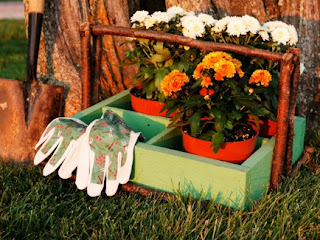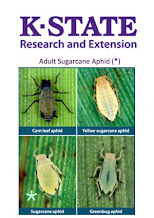Creating the Perfect Fall Garden
Cassie Homan, Horticulture Agent
Do you need a second chance with your garden this year? Lucky for you, fall is an excellent time for gardening in Kansas. Growing conditions are cooler in fall than spring, resulting in higher yields and better flavor. Some plants actually prefer the cooler temperatures and shorter days of fall.
Planting a fall garden is just like planting a spring garden with some big advantages. You will find the weed pressure to be much less and insect problems may be far fewer than in a spring garden. Seeds will germinate rapidly, so you will have crops up and growing in just a few days, compared to several weeks in the spring. Here’s some tips to planning your fall garden.
What to Plant
Space available and vegetable preference will influence the choice of crops to plant for fall production. With attention to watering and pest control, many vegetables that are already growing in the garden will continue to produce into the fall months. Cabbage, broccoli, cauliflower, and Brussel sprouts make excellent fall crops. Plant seeds rather than transplants. When young plants are a half inch tall, thin them to one plant per foot of row. Beets and carrots are also great choices. A light cover of sand or compost over the row will prevent soil crusting and improve emergence. Don’t forget to give veggies enough water to germinate, and throughout the season, if we don’t receive adequate rain fall. The cooler days and chilly nights of fall make it a great season to produce leafy greens such as spinach, kale, lettuce, collard greens, Swiss chard, and arugula. Plant these nutritious crops from now until early September and you will have a garden full of salad within a month. When light frosts hit in the beginning of winter, most of these greens can hold their ground and develop sweeter flavors.
Fertilizing
Too much fertilizer may damage young, tender plants, so use fertilizer sparingly at this time of year. In general, 1-2 lbs. per 100 square feet of a low-analysis, all-purpose garden fertilizer should be sufficient to produce a successful crop. Extensive soil preparation is not needed, avoid deep tillage as it may dry out soil moisture. A light soil cultivation will loosen the soil to prepare the seedbed. Additional amounts of fertilizer may be needed later in the season to ensure maximum plant growth and production.
Establishing Vegetables in Heat
 Fall gardeners will find that establishing a garden during the summer when soil temperatures are extremely high is difficult. One way to avoid seeding in adverse conditions is to establish plants in containers or pots for transplanting to the garden later in the season as the weather begins to cool. Crops like cabbage, broccoli, and cauliflower can be grown in cooler protected area, or under lights in a basement growing area for 2-4 weeks prior to setting in the garden. Remember to climatize the crops for several days before transplanting directly in the garden. Place flats in the sun and provide adequate water for a few days to allow the plants to become accustomed to the stronger winds, hot sun, and the harsh environment of the Kansas garden.
Fall gardeners will find that establishing a garden during the summer when soil temperatures are extremely high is difficult. One way to avoid seeding in adverse conditions is to establish plants in containers or pots for transplanting to the garden later in the season as the weather begins to cool. Crops like cabbage, broccoli, and cauliflower can be grown in cooler protected area, or under lights in a basement growing area for 2-4 weeks prior to setting in the garden. Remember to climatize the crops for several days before transplanting directly in the garden. Place flats in the sun and provide adequate water for a few days to allow the plants to become accustomed to the stronger winds, hot sun, and the harsh environment of the Kansas garden.
Take advantage of the start of this cooler season to spend some time in your garden. You may find that gardening becomes more enjoyable in the fall, with less heat, watering, and weeding. Get creative and have fun growing a fall garden.
For further information on creating a fall garden, contact me at any Post Rock Extension District Office in Beloit, Lincoln, Mankato, Osborne or Smith Center, or email choman@ksu.edu.
Do you need a second chance with your garden this year? Lucky for you, fall is an excellent time for gardening in Kansas. Growing conditions are cooler in fall than spring, resulting in higher yields and better flavor. Some plants actually prefer the cooler temperatures and shorter days of fall.
Planting a fall garden is just like planting a spring garden with some big advantages. You will find the weed pressure to be much less and insect problems may be far fewer than in a spring garden. Seeds will germinate rapidly, so you will have crops up and growing in just a few days, compared to several weeks in the spring. Here’s some tips to planning your fall garden.
What to Plant
Space available and vegetable preference will influence the choice of crops to plant for fall production. With attention to watering and pest control, many vegetables that are already growing in the garden will continue to produce into the fall months. Cabbage, broccoli, cauliflower, and Brussel sprouts make excellent fall crops. Plant seeds rather than transplants. When young plants are a half inch tall, thin them to one plant per foot of row. Beets and carrots are also great choices. A light cover of sand or compost over the row will prevent soil crusting and improve emergence. Don’t forget to give veggies enough water to germinate, and throughout the season, if we don’t receive adequate rain fall. The cooler days and chilly nights of fall make it a great season to produce leafy greens such as spinach, kale, lettuce, collard greens, Swiss chard, and arugula. Plant these nutritious crops from now until early September and you will have a garden full of salad within a month. When light frosts hit in the beginning of winter, most of these greens can hold their ground and develop sweeter flavors.
Too much fertilizer may damage young, tender plants, so use fertilizer sparingly at this time of year. In general, 1-2 lbs. per 100 square feet of a low-analysis, all-purpose garden fertilizer should be sufficient to produce a successful crop. Extensive soil preparation is not needed, avoid deep tillage as it may dry out soil moisture. A light soil cultivation will loosen the soil to prepare the seedbed. Additional amounts of fertilizer may be needed later in the season to ensure maximum plant growth and production.
Establishing Vegetables in Heat
 Fall gardeners will find that establishing a garden during the summer when soil temperatures are extremely high is difficult. One way to avoid seeding in adverse conditions is to establish plants in containers or pots for transplanting to the garden later in the season as the weather begins to cool. Crops like cabbage, broccoli, and cauliflower can be grown in cooler protected area, or under lights in a basement growing area for 2-4 weeks prior to setting in the garden. Remember to climatize the crops for several days before transplanting directly in the garden. Place flats in the sun and provide adequate water for a few days to allow the plants to become accustomed to the stronger winds, hot sun, and the harsh environment of the Kansas garden.
Fall gardeners will find that establishing a garden during the summer when soil temperatures are extremely high is difficult. One way to avoid seeding in adverse conditions is to establish plants in containers or pots for transplanting to the garden later in the season as the weather begins to cool. Crops like cabbage, broccoli, and cauliflower can be grown in cooler protected area, or under lights in a basement growing area for 2-4 weeks prior to setting in the garden. Remember to climatize the crops for several days before transplanting directly in the garden. Place flats in the sun and provide adequate water for a few days to allow the plants to become accustomed to the stronger winds, hot sun, and the harsh environment of the Kansas garden.For further information on creating a fall garden, contact me at any Post Rock Extension District Office in Beloit, Lincoln, Mankato, Osborne or Smith Center, or email choman@ksu.edu.









